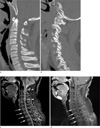1. Griffith HB, Gleave JR, Taylor RG. Changing patterns of fracture in the dorsal and lumbar spine. Br Med J. 1966; 1:891–894.
2. Bentley G, McSweeney T. Multiple spinal injuries. Br J Surg. 1968; 55:565–570.
3. Kewalramani LS, Taylor RG. Multiple non-contiguous injuries to the spine. Acta Orthop Scand. 1976; 47:52–58.
4. Calenoff L, Chessare JW, Rogers LF, Toerge J, Rosen JS. Multiple level spinal injuries: importance of early recognition. AJR Am J Roentgenol. 1978; 130:665–669.
5. Korres DS, Katsaros A, Pantazopoulos T, Hartofilakidis-Garofalidis G. Double or multiple level fractures of the spine. Injury. 1981; 13:147–152.
6. Tearse DS, Keene JS, Drummond DS. Management of non-contiguous vertebral fractures. Paraplegia. 1987; 25:100–105.
7. Gupta A, el Masri WS. Multilevel spinal injuries. Incidence, distribution and neurological patterns. J Bone Joint Surg Br. 1989; 71:692–695.
8. Keenen TL, Antony J, Benson DR. Non-contiguous spinal fractures. J Trauma. 1990; 30(4):489–491. Epub 1990/04/01.
9. Henderson RL, Reid DC, Saboe LA. Multiple noncontiguous spine fractures. Spine (Phila Pa 1976). 1991; 16:128–131.
10. Vaccaro AR, An HS, Lin S, Sun S, Balderston RA, Cotler JM. Noncontiguous injuries of the spine. J Spinal Disord. 1992; 5:320–329.
11. Green RA, Saifuddin A. Whole spine MRI in the assessment of acute vertebral body trauma. Skeletal Radiol. 2004; 33:129–135.
12. Qaiyum M, Tyrrell PN, McCall IW, Cassar-Pullicino VN. MRI detection of unsuspected vertebral injury in acute spinal trauma: incidence and significance. Skeletal Radiol. 2001; 30:299–304.
13. Eustace S, Keogh C, Blake M, Ward RJ, Oder PD, Dimasi M. MR imaging of bone oedema: mechanisms and interpretation. Clinical Radiology. 2001; 56:4–12.
14. Teli M, de Roeck N, Horwitz MD, Saifuddin A, Green R, Noordeen H. Radiographic outcome of vertebral bone bruise associated with fracture of the thoracic and lumbar spine in adults. Eur Spine J. 2005; 14:541–545.
15. Sanders TG, Medynski MA, Feller JF, Lawhorn KW. Bone contusion patterns of the knee at MR imaging: footprint of the mechanism of injury. Radiographics. 2000; 20:S135–S151.
16. Sijbrandij ES, van Gils AP, Louwerens JW, de Lange EE. Posttraumatic subchondral bone contusions and fractures of the talotibial joint: occurrence of "kissing" lesions. AJR Am J Roentgenol. 2000; 175:1707–1710.
17. Vaccaro AR, Hulbert RJ, Patel AA, et al. The subaxial cervical spine injury classification system: a novel approach to recognize the importance of morphology, neurology, and integrity of the disco-ligamentous complex. Spine (Phila Pa 1976). 2007; 32:2365–2374.
18. Aarabi B, Walters BC, Dhall SS, et al. Subaxial cervical spine injury classification systems. Neurosurgery. 2013; 72:170–186.
19. Goradia D, Linnau KF, Cohen WA, Mirza S, Hallam DK, Blackmore CC. Correlation of MR imaging findings with intraoperative findings after cervical spine trauma. AJNR Am J Neuroradiol. 2007; 28:209–215.
20. Demaerel P. Magnetic resonance imaging of spinal cord trauma: a pictorial essay. Neuroradiology. 2006; 48:223–232.
21. Bohndorf K. Imaging of acute injuries of the articular surfaces (chondral, osteochondral and subchondral fractures). Skeletal Radiol. 1999; 28:545–560.
22. Delgado Almandoz JE, Schaefer PW, Kelly HR, Lev MH, Gonzalez RG, Romero JM. Multidetector CT angiography in the evaluation of acute blunt head and neck trauma: a proposed acute craniocervical trauma scoring system. Radiology. 2010; 254:236–244.
23. Choi SJ, Shin MJ, Kim SM, Bae SJ. Non-contiguous spinal injury in cervical spinal trauma: evaluation with cervical spine MRI. Korean J Radiol. 2004; 5:219–224.
24. Panjabi MM, White AA 3rd. Basic biomechanics of the spine. Neurosurgery. 1980; 7:76–93.
25. Allen BL Jr, Ferguson RL, Lehmann TR, O'Brien RP. A mechanistic classification of closed, indirect fractures and dislocations of the lower cervical spine. Spine (Phila Pa 1976). 1982; 7:1–27.
26. Rihn JA, Fisher C, Harrop J, Morrison W, Yang N, Vaccaro AR. Assessment of the posterior ligamentous complex following acute cervical spine trauma. J Bone Joint Surg Am. 2010; 92:583–589.










 PDF
PDF ePub
ePub Citation
Citation Print
Print




 XML Download
XML Download